Cued Speech is a modality that makes spoken languages into visual languages. Cued Speech was developed by Dr. R. Orin Cornett at Gallaudet University in 1966.
Design
Cornett recognized that many of the distinguishing features of spoken sounds were not available to deaf children and that lipreading was not reliable. He devised manual signals that could be delivered with movements on the mouth. These signals reintroduce distinguishing features so that all the building blocks of English are unambiguous in a visual channel. This means that deaf children have visual access to the phoneme stream of English. Cues are assembled into syllables, words, sentences, adn conversational discourse. Fluent cuers can be produce cued English at a conversational rate.
Handshapes represent consonant phonemes. Placements and movements represent vowel phonemes. Cued Speech has been adapted to more than 50 languages and dialects.
While Cued Speech is the formal name of the system that Dr. Cornett developed, it does not represent speech. The cues do not show how we speak; that is, how we form consonants and vowels using our lips, tongue, and teeth.
Since we cue the phoneme stream, we are actually conveying language information at the most basic linguistic level.
Cues for American English
Vowels
Vowels in American English are represented by placements on the face or movements made from the side placement.
| Vowel Placement Cue | Vowel Phonemes | Examples |
 |
This placement is used when there is no vowel follwoing a placement. For example, if one were to cue, "Shhhh!" The handshape for the consonant /ʃshshʃshshʃshsh/ would be held at the side placement. | -- |
 |
/ɚûrurɚûrurɚûrur/, /iēeeiēeeiēee/ | dirty |
 |
/ɔôawɔôawɔôaw/, /ɛěehɛěehɛěeh/, /uo͞oueuo͞oueuo͞oue/ | small red shoe |
 |
/ʊo͝oooʊo͝oooʊo͝ooo/, /æăaæăaæăa/, /ɪĭiɪĭiɪĭi/ | look at it |
| /əəəəəəəəə/, /ʌŭuhʌŭuhʌŭuh/ | above | |
| /oʊōohoʊōohoʊōoh/, /ɑäahɑäahɑäah/ | gross sock |
Diphthongs
| Vowel Cue | Vowel Diphthongs | Examples |
| /ɑɪīieɑɪīieɑɪīie/, /ɑʊowowɑʊowowɑʊowow/ | eyebrow | |
| /ɛěehɛěehɛěehɪĭiɪĭiɪĭi/, /ɔɪoioyɔɪoioyɔɪoioy/ | play toy |
Consonants
Consonant phonemes are represented by the shape of the hand. One handshape can represent several phonemes as along as those phonemes look different on the mouth. In this way, the distinguishing features (of the hand in combination with the mouth) make every phoneme of English visually clear and unambiguous.
| Handshape Cue | Consonant Phonemes | Examples |
 |
/ppppppppp/, /ddddddddd/, /ʒzhzhʒzhzhʒzhzh/ | pirates dig treasure |
 |
/kkkkkkkkk/, /vvvvvvvvv/, /ðt͟htHðt͟htHðt͟htH/, /zzzzzzzzz/ | cows visit the zoo |
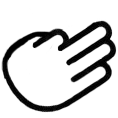 |
/rrrrrrrrr/, /sssssssss/, /hhhhhhhhh/ | rattlesnakes hiss |
 |
/ʍhwhwʍhwhwʍhwhw/, /bbbbbbbbb/, /nnnnnnnnn/ | whales bite nails |
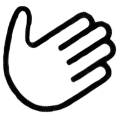 |
/ttttttttt/, /mmmmmmmmm/, /fffffffff/, | too many fish |
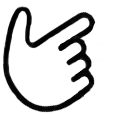 |
/ʃshshʃshshʃshsh/, /lllllllll/, /wwwwwwwww/ | sheep love wool |
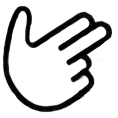 |
/ggggggggg/, /ʤjjʤjjʤjj/, /θththθththθthth/ | gorilla jewel thief |
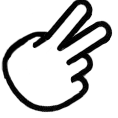 |
/jyyjyyjyy/, /ŋngngŋngngŋngng/, /ʧchchʧchchʧchch/ | young children |
Other terms to know:
- cued language - a language that is cued
- cued English/cued Spanish/cued Hebrew - a specific language that is cued
- spoken language - a language that is spoken (e.g., uses speech)
- signed language - a language that is signed
- written language - a language composed of orthographic symbols